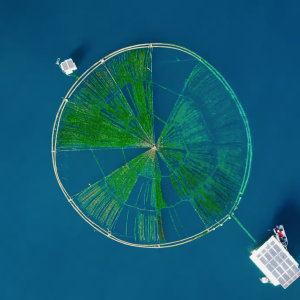
Seaweed farming is being championed as a magic bullet for food systems and the environment, promising to capture carbon, rehabilitate ecosystems and feed the world. Recent reporting from the Guardian investigates one seaweed enterprise, the Climate Foundation, and its mission to win Elon Musk’s $100m Xprize.
Summary
Director of the Climate Foundation, Von Herzen wants to ‘reforest’ the ocean with seaweed both to sequester blue carbon and to create beneficial byproducts such as feed and organic fertilisers. The company has already won a million pounds from Musk’s funds for its research in the Philippines. The process works through immersing a large ring of cables 120 meters deep into the ocean, where the water is cooler (24C compared with 30C on the surface) and richer in nutrients, both of which are needed for the seaweed to grow. However, the seaweed also needs light to photosynthesise CO2 into sugar and oxygen, so the ring needs to be raised once a day. This process allows kelp to grow rapidly, up to 50cm a day, three times faster than seaweed grows on the surface. Filipinos have long farmed seaweed themselves, with a one-hectare farm earning about £120 every 45 days through the prized export carrageen, an additive used in processed foods.
One question around seaweed farming for sequestering carbon centres around the need for cool water to encourage growth. Seaweed, similarly to coral, cannot withstand climate driven rising sea temperatures at the surface. The warming waters also stop the process of colder, nutrient-rich deep water rising and mixing with surface water (referred to as upwelling). Since 2011, seaweed production in the Philippines has fallen by 20% because of the effects of warming waters. The Climate Foundation submerges its seaweed to avoid these issues, but this puts the effectiveness of their process for carbon sequestration into question for the following reasons. Firstly, by disturbing the natural stratification of the ocean, a research unit at GEOMAR Helmholtz Centre for Ocean Research Kiel warns that farming is disrupting the natural CO2 storage in the depths of the ocean and is in fact bringing CO2 to the surface that would otherwise remain stored. The process of bringing nutrients back up to the surface could therefore cancel out the gains in newly stored CO2. Furthermore, through removing nutrients through farming, this process disturbs nutrients flows leading to deficits of nutrients elsewhere. At scale, this could lead to depletion of fish stocks in as hard to predict locations.
A second issue revolves around the challenge of making the industry profitable. The Climate Foundation investigated financing its work by selling carbon-removal certificates, but concluded that it alone would not be profitable. They must therefore also sell the seaweed as a product, leading to questions about the stability of CO2 storage in its product. Seaweed, like a forest on land, only stores CO2 for as long as it is not harvested and processed. In order to maximise CO2 storage through seaweed farming, the Climate Foundation would have to let its seaweed sink to the seabed where it would be eaten, decomposed or buried sediment, storing carbon deep in the lower layers of the ocean. The process happens to some extent naturally during the farming process, similarly to leaves falling from trees, and accounts for roughly 20-40% of the crop. The rest of the seaweed is harvested and used to produce fertiliser which it sells to local rice and fish farmers. This leads to questions about the permanence of the CO2 stored in soils that have been fertilised with seaweed.
Reference
Beller, S. (2023). ‘Like a 40-metre pizza’: the seaweed farms that could feed us all – at a cost, The Guardian, Fri 17 Nov 2023
Read the full article here and our own blog on microalgae as food as well as our feed podcast on scaling seaweed







Post a new comment »